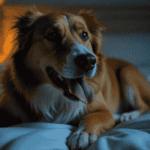The dog side eye is a familiar look for most pet owners. It can be funny, endearing, or even a little confusing. But what does it really mean when your dog gives you that sideways glance? In this post, we’ll explore the reasons behind the dog side eye, its significance in dog behavior, and how you can interpret this quirky expression.
By understanding this behavior, you can strengthen your bond with your dog and communicate more effectively.
What Is the Dog Side Eye?
The dog side eyes are that moment when a dog looks at you from the side of their eyes, without fully turning their head. It’s a look that’s often accompanied by a still body and can sometimes appear judgmental or suspicious. This behavior is common among dogs of all breeds and ages, and while it may look amusing, it’s an important part of how dogs communicate.
Why Do Dogs Give the Side Eye?
There are several reasons why a dog might give the side eye. These include:
- Caution: Your dog may be observing something they find suspicious.
- Discomfort: They might feel uneasy about a situation.
- Playfulness: Sometimes, dogs give the side eye during play.
- Warning: It could be a subtle signal that they want space.
Understanding the context in which your dog gives the side eye is key to interpreting what they are trying to convey.
Is the Dog Side Eye a Warning?

In many cases, the dog side eye can be a warning sign. If your dog is uncomfortable or feels threatened, they may give a side eye as a subtle signal to back off. This is often accompanied by other body language cues, such as a stiff posture or lowered ears. Paying attention to these signs can help prevent any escalation of discomfort or aggression.
Body Language Cues to Watch For
In addition to the side eye, here are other body language signs to watch for:
- Tense muscles: If your dog’s body is stiff, they might be feeling anxious.
- Lips curled back: This is a more obvious warning sign.
- Tail held low or tucked: Indicates nervousness or fear.
By understanding these cues, you can gauge your dog’s mood and take appropriate action to make them feel safe and secure.
When Is the Dog Side Eye Playful?
Not all side eyes are negative. Sometimes, the dog side eye is part of playful behavior. Dogs often give this look during a game of fetch or while playing with other dogs. In these situations, the side eye is accompanied by a relaxed body, wagging tail, and playful posture. It’s important to differentiate between a playful side eye and one that indicates discomfort.
Signs of Playful Side Eye
When the side eye is part of play, you may notice the following:
- Loose, relaxed posture: Your dog’s body is not tense or rigid.
- Wagging tail: A wagging tail is a clear sign of happiness.
- Bouncing or playful movements: These actions suggest your dog is in a fun, energetic mood.
If these behaviors accompany the side eye, your dog is likely feeling playful and enjoying their time with you.
How to Respond to the Dog Side Eye

Your reaction to your dog’s side eye should depend on the context. If your dog seems uncomfortable or cautious, it’s best to give them space. Respecting their boundaries will build trust and help prevent any negative interactions. On the other hand, if the side eye is part of play, engage with them! Play a game or offer a toy to keep the fun going.
Tips for Responding
Here are some practical tips for responding to your dog’s side eye:
- Give them space: If your dog seems tense, allow them to move away or find a quiet spot.
- Offer comfort: If they’re anxious, calm words or gentle petting can help reassure them.
- Engage in play: If the side eye is playful, join in with a toy or game.
By responding appropriately, you can strengthen your bond with your dog and ensure they feel comfortable and understood.
The Evolutionary Origins of the Dog Side Eye

The dog side eye is more than just a funny look—it’s rooted in canine behavior and evolution. Dogs are descendants of wolves, and many of their behaviors, including the side eye, come from their wild ancestors. In the wild, wolves and dogs used the side eye as a way to communicate subtle warnings or to observe their environment without drawing too much attention. This behavior has been passed down through generations and is still seen in domestic dogs today.
Why the Side Eye Is an Important Communication Tool
For dogs, the side eye serves several purposes:
- Non-verbal warning: It’s a way to communicate discomfort without resorting to growling or barking.
- Surveillance: It allows dogs to observe their surroundings without making themselves vulnerable.
- Social hierarchy: In a pack, subtle cues like the side eye help maintain order and prevent conflict.
Understanding the evolutionary background of this behavior can help you better interpret your dog’s actions and respond in a way that respects their instincts.
Common Myths
The dog side eye has become popular on social media, often associated with memes and jokes. While it’s fun to laugh at these expressions, there are some common misconceptions about what the side eye means. It’s important to debunk these myths so that dog owners can respond appropriately to their pets.
Myth 1: The Side Eye Means Your Dog Hates You
One of the most common misconceptions is that the side eye means your dog dislikes you. In reality, it’s often a sign of caution or curiosity. Your dog may simply be processing a situation and deciding how to react.
Myth 2: The Side Eye Is Always a Warning
While the side eye can be a warning, it’s not always the case. As mentioned earlier, dogs can give the side eye during play or when they’re simply being observant. Understanding the full context of the situation is crucial to interpreting the side eye correctly.
How to Build Trust and Prevent Negative Side Eye
To prevent negative reactions, such as the warning side eye, it’s important to build trust with your dog. By creating a safe, loving environment, you can reduce the chances of your dog feeling uncomfortable or anxious. Consistent, positive reinforcement and respecting your dog’s boundaries are key to building a strong, trusting relationship.
Tips for Building Trust with Your Dog

Here are some strategies to strengthen trust with your dog:
- Positive reinforcement: Reward good behavior with treats and praise.
- Respect boundaries: Allow your dog space when they seem anxious.
- Consistent routines: Dogs thrive on routine, so establish a regular feeding, walking, and play schedule.
By following these tips, you can create a harmonious relationship with your dog, reducing the chances of negative behaviors like the warning side eye.
FAQs
Final Thoughts
The dog side eyes arenmore than just a funny look—it’s a powerful form of communication. Whether your dog is feeling playful, cautious, or uncertain, the side eye can give you important clues about their emotional state.
By understanding the reasons behind this behavior and responding appropriately, you can deepen your connection with your furry friend. Always pay attention to the context in which your dog gives the side eye, and don’t be afraid to give them the space or attention they need.










